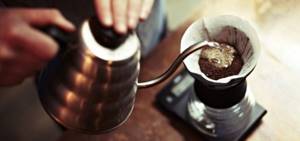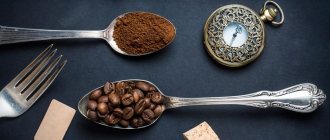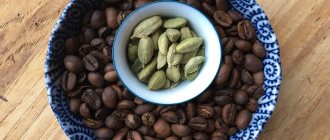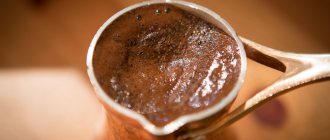How to make filter coffee at home
What’s interesting is that it was from preparation in this way that such a drink appeared. One German housewife tried using blotting paper to strain her coffee. You can make a simple filter at home using available tools.
You will need a funnel. As a filter, you can use kitchen towels or paper napkins folded 3-4 times (unscented only).
- Make a cone from the prepared paper and place it in a funnel;
- Place a funnel with paper over the cup;
- Pour in medium-ground coffee, making a full teaspoon per serving;
- Gently, in a thin stream, in a circular motion, pour water through the coffee;
- You can move the thicket a little with a spoon, but do not press, otherwise you will break through the paper;
- You get the finished drink in a cup. You can add sugar and drink coffee.
Filter coffee is very popular, its taste has won many fans and is worth trying. The point is that, under the force of gravity, the water slowly drips through the coffee layers, the grounds remain on the filter, and the drink turns out to be quite strong and rich.
Turka: an old new take on light roast
Once upon a time, a long time ago, I believed that Turk was not intended for light roasting. Of course, this was a fallacy. Having once tried at Cezve Coffee on Pushkinskaya light-roasted washed Ethiopia in Turk (and the guys specialize in Turk) - coffee that I knew: it was, as far as I remember, Limu Eleana), I was amazed at how well the coffee revealed itself. Some time has passed since then, the memory of this experience is preserved, but they never got around to conducting a series of tests. In everyday life I drink the V60 funnel, the consistency of the drink is different from what you get in Turk, and it was not easy to switch. But somehow everything happened by itself.

I was with my family in Montenegro when I found out that Dmitry Potapenko, who a year ago, when I was in Turkey, had the guys visit him on Komsomolskaya Pravda, invited us again, this time to Echo of Moscow . This time I no longer had a chance. I had to buy tickets and fly to Moscow in order to return back to my family the next day.

All my coffee equipment remained in Montenegro. At night after the broadcast, we were sitting in my kitchen, and somehow the conversation turned to the Turk. I said that I heard that there is an idea that using the finest grind in Turk - to dust - is completely optional, and even more than that: using a coarser - almost funnel - grind can give noticeably more interesting results when using a light roast. No sooner said than done. We took Kenya Kiamariga, measured it by eye (but I remember that there was a lot), ground it under a funnel, and brewed it. The result was extremely pleasant. The coffee was juicy and the acidity was intense. The coffee, of course, was different from what I was used to seeing in the funnel - primarily, perhaps, in consistency - but it was a very, very interesting result.

A little later, everyone left, and while waiting for the morning flight back, I repeated the experiment by brewing Colombia San Pascual. The result was again very interesting. There were cranberries, fermented bitter berries, and the sweetness of Pascual. In short, the taste profile was quite accurate. Despite the fact that I didn’t try different grinding options, I used the dosage by eye, and brewed coffee in an extremely primitive Turk from Ikea (which can only be called a Turk with a big stretch, but there was nothing else at hand that night) - I was extremely pleased with the result. The conclusion became clear: light roasted coffee opens up perfectly in the Turk with medium (like a funnel) grind.

Returning to Montenegro, I continued to drink coffee in a funnel, while at the same time trying out a necessary measure - ziplock bags, which, as it turned out, many people liked more than our branded ones. I can’t say that I share our customers’ delight in this packaging, but there’s nothing to be done – the customer knows best. What small conclusions did I draw for myself while, so to speak, two weeks in coffee isolation?
- The 450 g package is not suitable for a funnel (and probably other “non-espresso” brewing methods). On the one hand, it takes a very long time to run out of coffee and by the end of the pack you get completely bored. On the other hand, already 200 grams of beans begin to smell a little rancid - they oxidize, which additionally contributes to the fact that you try to finish it as quickly as possible and do not open new packs - and in the meantime, the coffee gets even more boring. Previously, the idea arose to limit the packaging options for light roasting to small sizes only, so that no one would step on the same rake.
- Group C coffee behaves quite boringly in the funnel. I drank Irgu, Papua and Sumatra. All coffees are similar to each other, bitter caramel shades hide a barely detectable sourness. However, I think this is a plus, because after all, we focus group C on espresso, and we do not recommend a funnel (or Chemex) as a preparation method - and for this reason, by the way.

To sum it up.
Light roasting in Turk turns out great. What does it take to bring out the flavor?
- medium grind – almost like our “Aeropress” (or like a funnel),
- normal coffee grinder
- the right water (I never tire of recommending Bonaqua as a brand of water available everywhere),
- dosage according to the “more is not less” principle.
If you drink Turkish coffee and have never tried light roast coffee, I think you will be pleasantly surprised by this experience! And I, as always, will be happy to answer any comments on this material. Good luck!
PS As for packages, our team is now working hard to introduce the ability to select the type of packages when ordering. Friends, thank you for your feedback on ziplock bags. Of course we heard you! I think that by the time branded packages arrive from China (which I expect in 2 weeks), this feature will already be implemented on the site.
Filter coffee: what does it mean?

The coffee list contains names such as “Chemex”, “Kalita”, “pourover”. "Aeropress". This method of preparation has won many fans, both among amateurs and avid coffee lovers. If you haven't tried filter coffee yet, be sure to learn more about it and, of course, try it.
Coffee has many advantages, but also has some disadvantages. The most serious of these is the harm that unfiltered coffee can bring to those with heart problems or high cholesterol.
But for those who care about their health, but do not want to give up their favorite drink, there is a type of coffee that is practically free of this drawback. This is filtered coffee, which has a high level of caffeine and virtually no substances that our body does not absorb. A property that makes such a drink practically harmless. Once you try and love it, you can enjoy filtered coffee not only in a coffee shop, but also easily prepare it at home.
Softening (cleaning) coffee moonshine from smell and fusel oils at home
Natural bean coffee has always been valued for its unique aroma and rich taste. Coffee is also used to refine strong homemade alcohol. In what cases is this necessary and is it possible, for example, to purify coffee moonshine? Let's figure it out.
How to clean coffee moonshine from smell and fusel oils at home
Even if you are lucky enough to buy a high-quality moonshine still (we recommend choosing one with a Luxstahl 6 distillation column), sometimes the quality of the resulting drink may be mediocre. This could be due to a number of reasons, but we will not dwell on them. If the distillate turns out to be too unaromatic or cloudy, then a full purification or even another distillation is necessary. And if the quality of the drink turned out to be quite good, but the taste is harsh or there is a not very pleasant smell, then you can use a simpler method.
Coffee will help mask the unpleasant odor of the distillate if it is weak or moderate. However, coffee cannot remove fusel impurities from a drink: it does not glue impurity molecules together, like milk, for example, and does not sorb like coal. And the coffee components do not enter into a chemical reaction with impurities. It turns out that we can only talk about softening moonshine with coffee. But the taste and smell of the drink really change for the better when using coffee beans. Of course, we are talking about a ready-made drinking distillate, but not about raw alcohol.
Softening moonshine with coffee
At its core, the softening procedure is the preparation of a moonshine tincture for coffee.
You will need:
- a liter of moonshine with a strength of 45-50 degrees;
- 100 grams of ground coffee beans;
- 300 ml water;
You can also add sugar syrup or honey to taste.
Preparation:
- Brew coffee in a Turkish coffee pot, strain the grounds and cool.
- Pour the coffee into the moonshine, close the container with a lid and put it in the refrigerator for 7 days.
- After the specified time, the drink is ready for consumption.
Softening moonshine with coffee and citrus fruits
There is also an option for everyone with the addition of citrus fruits.
You will need:
- liter of moonshine
- 60 roasted coffee beans (not ground)
- lemon or orange (whole)
- 7-10 tablespoons sugar
The result will be something like a coffee-citrus liqueur.
Preparation:
- Wash the orange (or lemon) clean, pour boiling water over it and make cuts in the peel for coffee beans.
- Place coffee beans in the cuts, put the entire structure in a jar and fill with moonshine.
- Close the lid and leave in a dark place for 30 days.
- Strain the finished drink through a cotton-gauze filter and you can start tasting.
Of course, you need to take into account that coffee will impart its invigorating effect to moonshine. Therefore, you need to drink this drink without fanaticism. Softening moonshine using various methods can be useful when you had to make a moonshine still with your own hands, and you have just started to “break in” it. Well, if you know how to choose a moonshine still correctly and strictly follow the distillation technology, then additional methods of purifying and softening the moonshine will be used extremely rarely.
Subtleties of making Turkish coffee
The taste of brewed coffee depends on a number of nuances. And to prepare the perfect, delicious coffee drink, you must adhere to the following rules:
- buy whole grains, not already crushed ones;
- carefully choose bean coffee - we described how to do this in one of our previous publications;
- check the quality of roasting of the beans - if it is a light roast, then the beans should have a slightly tanned appearance, not dark;
- Proper grinding is the key to making delicious coffee.
Features of grinding coffee beans
Grinding coffee beans is one of the important processes in preparing coffee, which determines the taste and aroma of the finished drink. During the preparation of coffee, the flavoring substances from the crushed beans begin to gradually pass into the water.
The acids are transferred first, and minerals are released only at the very end of the grain. This process is called extraction. During strong heating, aromatic substances disintegrate, which is why it is not recommended to bring coffee to a boil.
If coffee is ground into large fractions, the extraction process will occur quickly, and the resulting drink will be slightly sour. Beans crushed into dust, on the contrary, will give bitterness and excessive thickness. And to make delicious, aromatic coffee, experienced baristas recommend using beans ground to medium-sized fractions.
To grind the beans to the desired fraction size, you will need a coffee grinder. There are 4 grinding levels:
- Large. Bean fractions have a size of 2-3 mm. This type of grinding is considered ideal for coffee pots and coffee makers. Whereas for Turks it is absolutely not suitable. Unless you like coffee with sourness.
- Average. Universal grinding degree. After grinding, the grains are the size of grains of table salt.
- Small. The beans are ground to powdered sugar. It is considered the ideal type of grinding to make Turkish coffee.
- Ultra-thin. The grains are crushed almost into dust. This coffee can be prepared even in a cup without pre-cooking. The fractions are so small that they do not settle to the bottom, and the finished drink is strong and thick.
Water level
Water is poured into the Turk to a level below the beginning of the narrowed part of the neck. If you pour too much water, the coffee will run away before it has time to brew. And thanks to the narrow neck, the drink practically does not come into contact with air, and all oils, aromatic and flavoring substances dissolve in water.
Heating level
First of all, the Turk is heated over low heat, and only then ground coffee, sugar and other flavorings are poured into it. All components are lightly fried and then filled with water. Moreover, the colder the water, the tastier the drink will be. However, the specifics of preparation largely depend on the recipe.
How to determine the readiness of a drink
The process of making coffee takes a few minutes, and it is better to free yourself from other extraneous matters during this time. As soon as the coffee begins to boil and rise up the neck, remove the Turk from the heat and wait for the foam to settle. If you want to save the foam, then immediately transfer it into a cup with a spoon. The coffee brewing procedure is repeated 2-6 more times, without bringing the drink to a boil.
Filter coffee: how to prepare
To prepare filtered coffee, only medium or strong roast beans are used. This provides the rich taste and distinct aroma for which this drink is famous. Today this drink is prepared using special coffee makers and coffee machines. The cooking technology itself is as simple as possible. To make filter coffee, take 10 grams of ground beans, place them in the coffee maker and turn it on. After 6-8 minutes you get a cup of an invigorating, aromatic drink.
You just need to take into account that the technology for preparing filtered coffee has its own characteristics. For example, the grains should be medium grind. Small ones won't work, you can't filter them out. Grinding the beans too coarsely will not allow the coffee to release the beneficial substances it contains. To prepare filtered coffee, water at a temperature of 90 degrees is used, which is passed through ground beans without pressure.
With this preparation method, the almost finished drink is passed through paper filters. These filters trap most of the harmful substances, making the drink harmless.
We especially note that this method of purification, as well as the specifics of the preparation technology itself, makes it possible to obtain coffee that has a particularly pleasant taste. Currently, the popularity of filtered coffee is growing rapidly; many recipes for all kinds of cocktails are created based on this drink. Filtered coffee itself is already recognized by many as a quality and ideal option for morning coffee drinking and throughout the day in a friendly company.











